Qualcomm Announces 205 Mobile Platform: Entry-Level LTE for India & Emerging Markets
by Ryan Smith on March 20, 2017 3:01 AM EST- Posted in
- SoCs
- Qualcomm
- LTE
- Mobile
- snapdragon 200
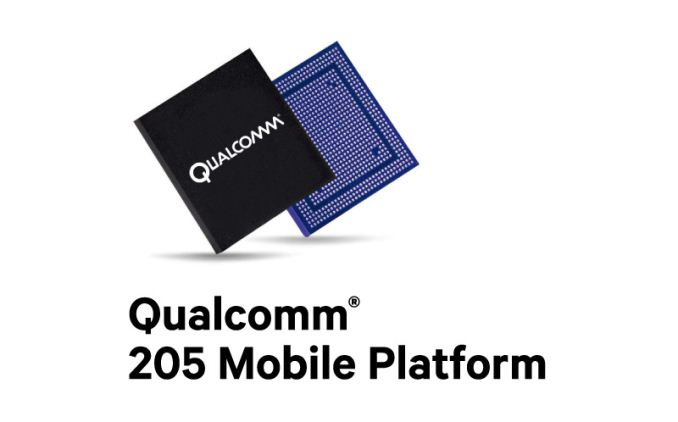
This morning in New Delhi, Qualcomm is taking the wraps off of their latest entry-level, high-volume SoC, the Qualcomm 205 SoC. The cornerstone of the Qualcomm 205 Mobile Platform – and keeping in mind last week’s renaming of Qualcomm’s product stack – the 205 Platform is being launched as Qualcomm’s new entry-level SoC for emerging markets. Qualcomm’s focus on this latest 200-series SoC is bringing an LTE-enabled SoC down to its lowest price point yet, ultimately aiming to get LTE into the sub-$50 mass-market feature phones that are popular in these markets.
| Qualcomm's 200-Series SoC Lineup | |||||
| 205 SoC | 208 SoC | 210 SoC | |||
| CPU | 2 x ARM Cortex A7 @ 1.1GHz | 2 x ARM Cortex A7 @ 1.1GHz | 4 x ARM Cortex A7 @ 1.1GHz | ||
| GPU | Adreno 304 | Adreno 304 | Adreno 304 | ||
| Memory Interface | 32-bit LPDDR2/3 | 32-bit LPDDR2/3 | 32-bit LPDDR2/3 | ||
| Integrated Modem | Snapdragon X5: LTE Category 4, HSPA+, DS-DA, VoLTE | Gobi 3G: HSPA+, DS-DA | Snapdragon X5: LTE Category 4, HSPA+, DS-DA, VoLTE | ||
| Integrated WiFi | 802.11n 1-stream | 802.11n 1-stream | 802.11n 1-stream | ||
| Manufacturing Process | 28nm LP | 28nm LP | 28nm LP | ||
| Video Encode/Decode | Decode: 720p30 Encode: 480p30 |
Decode: 720p Encode: 720p |
Decode: 1080p Encode: 720p |
||
| Launch Date | 03/2017 | 09/2014 | 09/2014 | ||
From a technical perspective, Qualcomm has offered LTE in the 200 series SoCs since the 210 SoC in 2014. However this was on a slightly more premium quad-core CPU design, whereas Qualcomm’s cheapest SoCs are even simpler dual-core designs. The difference comes down a fraction of a dollar, but for emerging markets looking to push out to LTE – and with many of those markets subsidizing phones – even the cents matter. So now Qualcomm is rolling out a dual-core design with LTE, offering an even more basic design than the 3G-only 208 or the LTE-equipped 210.
At a high level, the specs are unremarkable and appropriately simplistic. We’re looking at a dual-core Cortex-A7 CPU running at 1.1GHz and paired up with an Adreno 304 GPU, and, most importantly, one of the company’s X5 LTE modems. The X5 is a basic modem design that offers up to LTE Cat 4 speeds (150Mbps down/50Mbps up), which is more than sufficient for Qualcomm’s goals with LTE for emerging markets. Dual-sim functionality is present, as is VoLTE and VoWiFi as well. Video encode/decode are very basic, offering 720p30 decode and 480p30 encode, with a display controller capable of driving just a VGA (640x480) display, all of which is a notable reduction from the 208/210. The Hexagon DSP has been removed as well, saving further die space. Even the chip itself is designed to save a few pennies on implementation; it’s pin-compatible with the 210/208 so that it can be dropped into existing designs.
Qualcomm’s big push for LTE connectivity in entry-level phones in India and other emerging markets comes as the company expects both consumers and carriers in those markets to make the transition over to LTE, which in turn means phone manufacturers are in need of a cheap platform that can handle LTE. Though the definition of what exactly a feature phone is in 2017 is a bit muddled – the form factor seems to be the only defining element when even the OSes are now full-fledged systems based on ASOP and other Linux projects – they remain the cheapest phones, and Qualcomm expects them to benefit from LTE in similar ways as smartphones have over the last several years.
Underpinning all of this is of course the massive spectrum efficiency gains in LTE versus 3G & 2G communication protocols, which increase the bandwidth available in a given area even without a larger number of towers. Otherwise Qualcomm expects the use cases for feature phones to be many of the same ones as smartphone users already do, if only on a smaller scale: social media, video streaming, etc. Meanwhile, one claim that particularly caught my attention is that Qualcomm is expecting to be able to get 45 day standby out of 205 phones; while 205 is of course designed for low power operation, with a 2000mAh battery this works out to a standby power consumption of just 6mW.
Finally, Qualcomm is noting that the 205 SoC and its associated software were all developed in India, as part of fulfilling the country’s Make in India initiative, which at a couple of years old now, is intended to encourage manufacturers to invest in manufacturing within the country rather than importing finished products. While Make in India and the country’s associated attempts to encourage internal manufacturing have not always been well received – Apple and others have balked at the concept at times – it has been successful in driving semiconductor companies like Qualcomm towards developing entry-level hardware in the country. Though in Qualcomm’s case, the company has operated a development center for a lot longer than just the last couple of years.
Wrapping things up, Qualcomm is shipping the 205 Mobile Platform today. Phones based on the platform will be showing up quickly thereafter, with the first devices expected next quarter.


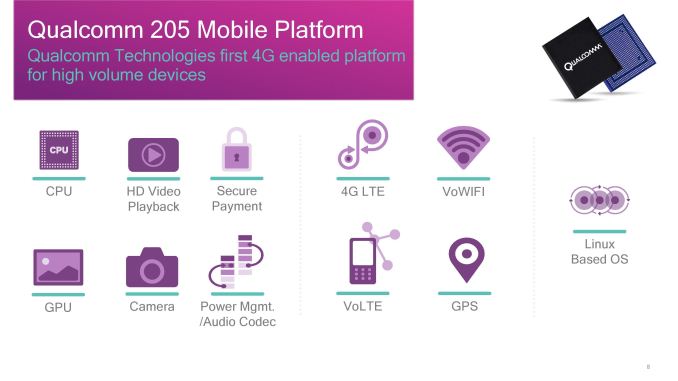
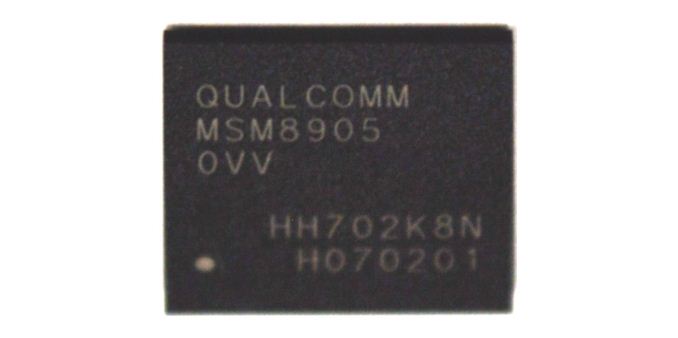
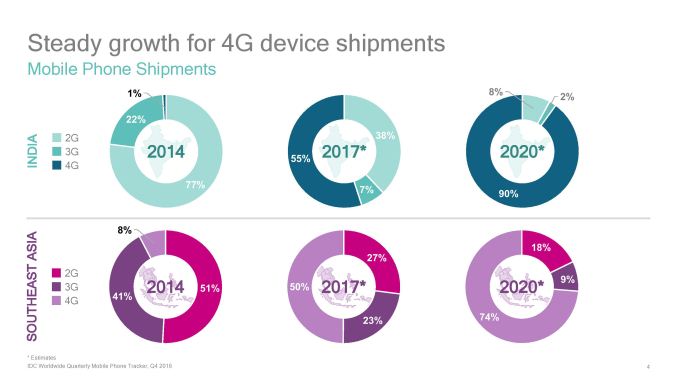
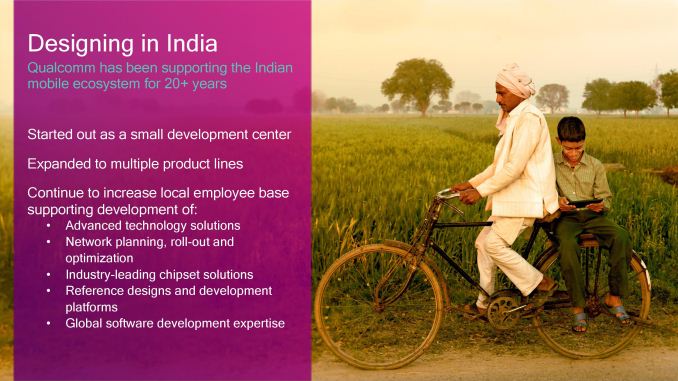
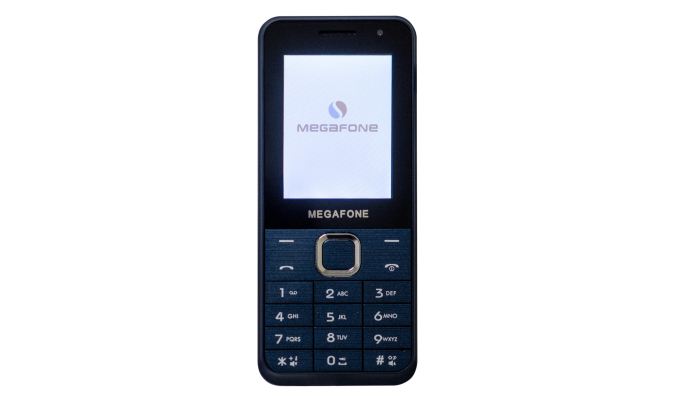














27 Comments
View All Comments
BrokenCrayons - Monday, March 20, 2017 - link
Pretty cool stuff! I wonder if the new 205 will end up going global or if it's going to be an India-only product. The US could certainly do well with phones that have 45 days of standby time and more sane pricing.webdoctors - Monday, March 20, 2017 - link
This is not cool stuff! A few years ago some chinese SoC company, maybe HiSense or another was selling quadcore +modem SoCs for under $5. By now its probably a $1. The reason folks are buying the QCOM version is not because the QCOM one has more features or is cheaper, its because than they get the LTE patent license fees for less.This is a shady practice, they're strong arming manufacturers to use their crap chips, otherwise folks will get sued. Shame on the media for not exposing these tactics. SAD.
BrokenCrayons - Monday, March 20, 2017 - link
What's not to be excited about? This is a reasonable SoC that's got nice specs and support for LTE. It's what I'd love to see more of in modern phones and tablets. We could get a little more battery life out of our devices for those of us that don't really care about performance after a point.Death666Angel - Monday, March 20, 2017 - link
I fail to see what's exciting about an SoC that is terribly outdated. I tried using my Galaxy Nexus a few weeks back and it feels ancient with the load times of apps and websites. Even my Nexus 6 can't load apps and websites as fast as my PC or Laptop on the same Wifi, leading me to think that there are SoC performance issues more than internet bandwidth ones. So having LTE in such an underpowered SoC doesn't feel like it will add to the experience.Also, I can't believe you are impressed by their standby times. When was the last time anyone cared about phone standby? Or don't you do anything with your modern phone? If so, why not just get a flip phone, they already have terrific standby duration. Do you care if your laptop can last 48 hours with the display off and in connected standby? Because most people don't, they intend to use these things.
BrokenCrayons - Monday, March 20, 2017 - link
I really don't understand the hostility over someone's excitement in reading about a new budget SoC. I also don't understand why you'd compare a desktop or laptop to a phone and be surprised by the fact that the desktop and/or laptop are faster than the phone and I'm not sure why those platforms are even comparable. You're implyingapps and websites don't load as quickly, but what apps do they share in common and how is the browsing experience comparable at all?As for phones, I don't currently have one. I was previously issued a Blackberry 8820 by my employer in 2009. A year or so later I purchased a Virgin Mobile LG Optimus V (3.2 inch screen, 600MHz single core, 320MB RAM, etc.) and it was fast enough. I only carried service for a couple of months before I quit and started loading custom ROMs to tinker with it. It's in a drawer someplace now and has Cyanogen 10.1 (jellybean IIRC) on it. Web browsing over WiFI on it was perfectly acceptable last time I powered it up, but that was a few months ago. Maybe you're just not patient or have unrealistic expectations.
fanofanand - Tuesday, March 21, 2017 - link
I see both sides of this discussion, though I don't understand the anger/rage being displayed. The A7 is an ancient chip that needs to go away. A35's use less power while providing a better user experience, and the chip itself is absolutely tiny. It would seem to be even more cost effective than A7's in addition to being more performant.As an aside, I went two years without a phone. The first few months was brutal, but then it was WONDERFUL! Yes, it's annoying not being able to research things on the spot, or many of the other things modern mobile phones provide, but the ability to be "unreachable" was priceless. BrokenCrayons isn't as crazy as some might think.
Ryan Smith - Monday, March 20, 2017 - link
Yes, it will be available world-wide. Though I would be surprised to see it come to the US, simply because the market for such a phone is very small relative to more profitable smartphones.BrokenCrayons - Monday, March 20, 2017 - link
Thanks Ryan! There are probably alternatives out there in the budget handset market. They don't get the publicity of top end models though.vtomin - Monday, March 20, 2017 - link
Am I the only one who is thinking of DESK PHONES with VoLTE support? Here where I live (Eastern Europe) we still use fixed telephony a lot in enterprises. It would be great if we could eliminate the legacy telephony system and move entirely to the converged VoLTE system. I think you call this "cord cutting". What is it like in USA? Do you still use fixed line phones in enterprises? If yes, then isn't this a disruptive game-changer?DanNeely - Monday, March 20, 2017 - link
My old job (a company with ~400 people down from ~1400 a decade ago) had desk phones. My new one (~40 people) only has company phones in the conference rooms/etc. In both cases they're VOIP systems run over wired internet.